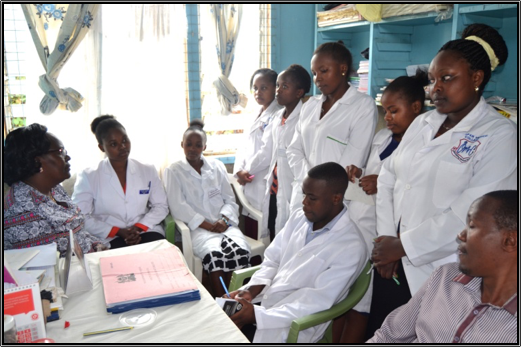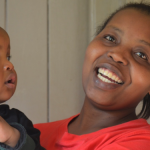Murang’a County is working hard to be able to sustain Vitamin A Supplementation (VAS) programme in the county when partners exit in the future.
According to the County Nutrition Co-ordinator, Nancy Waitherero Mwangi, the partnership between the Government, Nutrition International (NI), and Centre for Behaviour Change and Communication (CBCC) has not only boosted their efforts in scaling up Vitamin A coverage, but also helped establish a sustainable long-term structure and system.
“We already have many community units doing health-related work. Community Health Volunteers (CHVs) in particular are important for where we are heading. They, alongside other health workers, are ready to run with the work when the programme comes to an end.” Nancy remarks.

The VAS programme is being implemented through four channels including: community units, health facilities early childhood development education centres (ECDE), and outreaches. At the end of the programme, Nancy anticipates that outreaches will be a harder to sustain at current levels. “Outreaches are costly and difficult but we can carry them out occasionally. And again, since people are unlikely to put their work aside to come and listen to you in the communities during the outreaches, it might be necessary to complement this channel with smart, well-targeted media messages.”
Nancy believes that this partnership has given the Murang’a County Nutrition Team sufficient momentum to keep them soaring with their own wings. “Yes, there will be challenges but since we now understand things better, we will find solutions.”
Just what has been the impact of the partnership with NI and CBCC on the accessibility of VAS to children across the county? According to Nancy, the partnership has performed a miracle of sorts by placing VAS in virtually all the government health facilities in Murang’a. VAS is not only available even in places where nutritionists don’t exist, it is found in virtually all types of facilities – public, private and faith-based. The coverage might not be 100%, but any child aged between 6-59 months who visits a facility of whatever kind is guaranteed to have access to VAS.

Murang’a has seven sub-counties: Kiharu, Kangema, Mathioya, Kigumo, Gatanga, Murang’a South, and Kandara. Nancy’s office ensures that a Vitamin A activities coordinator who oversees real-time knowledge, staff mentorship, and guidelines establishments and dissemination is present in each sub-county. “Furthermore, we continue to advocate for increased budgetary allocation for nutrition services for the whole county even as we act as the link between county management and service providers. All these have prepared us to continue with the good work when partners leave.”
Just what are the challenges Muranga faces in making VAS available to every child?
“We have had a challenge with documentation,” Nancy answers. “It means the figures have been inconsistent. What we have done recently, with the help of the VAS Project, is to scale up data capture sensitisation. Within the office I ensure that the staff have all they need to capture data and aggregate it into the District Health Information Software DHIS. We are also working a lot more closely with the Health Records Department to ensure no data loss. Besides, we have scaled up the capacity building of CHVs in ensuring data integrity. As part of encouraging the CHVs to do the job, the County Government is supporting one thousand of them with KSh. 4000 monthly stipend.”
Nancy and her department conduct quarterly data review meeting to assess their progress and identify gaps and emerging issues. One challenge for documentation was parents bringing their new-born babies to facilities, but then not returning unless the child falls sick. “Not only do we document this at the facility and note in the Mother Child Booklet when the child should be returned, the health workers inform mothers of the benefits of returning the child.” Nancy says. “CHVs are also given information about these mothers and follow them up to make sure they return.”
Murang’a has seven sub-counties: Kiharu, Kangema, Mathioya, Kigumo, Gatanga, Murang’a South, and Kandara. Nancy’s office ensures that a Vitamin A activities coordinator who oversees real-time knowledge, staff mentorship, and guidelines establishments and dissemination is present in each sub-county. “Furthermore, we continue to advocate for increased budgetary allocation for nutrition services for the whole county even as we act as the link between county management and service providers. All these have prepared us to continue with the good work when partners leave.”
Just what are the challenges Muranga faces in making VAS available to every child?
“We have had a challenge with documentation,” Nancy answers. “It means the figures have been inconsistent. What we have done recently, with the help of the VAS Project, is to scale up data capture sensitisation. Within the office I ensure that the staff have all they need to capture data and aggregate it into the District Health Information Software DHIS. We are also working a lot more closely with the Health Records Department to ensure no data loss. Besides, we have scaled up the capacity building of CHVs in ensuring data integrity. As part of encouraging the CHVs to do the job, the County Government is supporting one thousand of them with KSh. 4000 monthly stipend.”
Nancy and her department conduct quarterly data review meeting to assess their progress and identify gaps and emerging issues. One challenge for documentation was parents bringing their new-born babies to facilities, but then not returning unless the child falls sick. “Not only do we document this at the facility and note in the Mother Child Booklet when the child should be returned, the health workers inform mothers of the benefits of returning the child.” Nancy says. “CHVs are also given information about these mothers and follow them up to make sure they return.”

As Nancy’s office overcomes the challenge of documentation, they grow in confidence at solving the other sustenance challenges they might face. For instance, they have a related challenge of integrating data. “There are many challenges but the first is always finding the child. We have to go where the child is. But then how do we integrate all data – facility, home and ECDE – since the system recognises only one data? We need a single tally sheet that easily allows for easy aggregation of the data; yet in the computer, the channel is only one – health facility. So, we created a tool which has helped minimise data loss.”
Nancy reserves special acknowledgement of the value of their partners. “Our partners have been our backbone. They have been absolutely helpful in capacity building for the trainers of trainers (TOTs), CHVs, and Community Health Extension Workers (CHEWs) and we will continue with that. Their support in the availability of Information, Education and Communication (IEC) materials such as posters, comic books and policy statements and other materials has been very helpful.
As part of scaling-up the availability of VAS, Nancy and her team are targeting men. “We do not want them thinking it is only women and/or mothers who should watch out for children’s health. We tell them that in the African setting a child is the father’s. That is why a child is identified by who his/her father is. We are further encouraging staff not to ask female caregivers where the fathers are and not express surprise when a father brings his child to receive VAS.”
Clearly, Nancy’s positive attitude will be key in sustaining VAS in Murang’a County.




